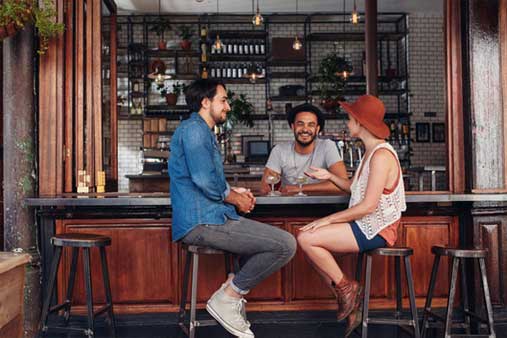How to Cup Coffee: an Introduction
Cupping is the standard way to sample coffee. From producers to baristas, everyone in the coffee world uses this process to help them categorize different coffees and inform buying decisions. However, this practice is not exclusive to coffee industry professionals. Coffee cupping can provide a fun, educational activity for specialty coffee patrons as well. Keep reading to learn more about this process and how to bring cupping to your cafe as an engaging customer activity.
Recommended: Read our full, in-depth How to Start a Coffee Shop Business guides, inspired by coffee professionals, they will help make your coffee dreams real, from sourcing beans to hiring baristas, forming an actual company, and everything in between.

The Importance of Cupping
Beyond assigning flavor profiles to individual coffees, coffee importers, roasters, and cafe owners use cupping to categorize and evaluate many different aspects of coffee. For example, when sourcing coffee beans from a producer at the origin, buyers will cup the coffee in order to assess consistency and check for any defects. Without this sampling process, buyers risk ending up with entire lots of unusable coffee due to differences in the beans.
Checking for any differences in the beans is the main reason why cuppings typically test three samples of the same type of coffee simultaneously. If a potential buyer finds one outlier in a cupping, for example, they typically view that inconsistent cup as a result of human error and not representative of the coffee. They would instead rely on the other two cups to inform them about the coffee’s flavor profile and other key aspects.
Once a roaster buys a number of green coffee beans, they use this method to describe the coffee’s flavor to their customers as well as to inform the roast level. In some cases, roasters also may use cupping results to decide if they will feature a coffee in a blend or as a single origin.
If you need help with getting a logo for your Coffee Shop, try branding your small business with our Free Coffee Shop Logo Maker. You get your logo in minutes so you can immediately start branding your small business.
Key Considerations Before You Start
Here are a few tips to keep in mind before you start cupping your coffee:
- Consistency is key. Because you’ll use this process to assess different coffees and identify any defects, consistent preparation is the most important step. For example, be sure to maintain the same grind and volume for every cup.
- Be timely about each step. From grinding to tasting, the cupping process spaces out each step to ensure optimal coffee sampling. As such, it’s vital to stay on schedule in order to fully assess each coffee.
- Use a flavor wheel. Display a coffee flavor wheel at your cupping to help tasters assign flavors to each coffee. Developing a palette for cupping coffee takes time and experience, so having the right tools and vocabulary available will make it easier for beginners to assess a coffee.
The Step-By-Step Process
When you’re ready to conduct a cupping session, be sure to follow these key steps:
- Assemble your equipment and supplies. You will need whole bean coffee (at least 50 grams), hot water, a kettle, three cup-sized vessels, a grinder, a small tray, spoons, a bowl, and a timer. Optional items include a flavor wheel, notepads, and writing utensils.
- Prepare your coffee samples. Start by measuring out 10.5 grams of your whole bean coffee into three cup-sized vessels (these work well). Save some of your whole beans to place in a tray or vessel in the middle of the cupping table. Then, immediately before starting the cupping session, grind each 10.5-gram sample of coffee at the same grind you use for drip coffee (typically between an espresso and a French press grind). Be sure to clear the grinder chute between each cup to ensure an equal dosage. Finally, fill a bowl with hot water and set it aside.
- “Dry smell” each coffee sample. “Dry smelling” refers to smelling the dry, freshly ground coffee. Coffee releases a variety of natural gases when you agitate the grounds. Do this by tapping the side of the cups to move the grounds around and then take a sniff.
- Steep each coffee sample. Fill each coffee sample cup with hot water — at roughly the same time — to the brim and let them steep for four minutes. Be sure to fill each cup with the same amount of water in order to maintain consistency.
- “Break the crust” on your samples. This is the process of agitating the top layer of the now-steeped coffee grounds. This layer will appear lighter, almost like the crema of an espresso. In one motion, take your spoon and drag it through the crust away from you as you smell each cup. Between each cup, be sure to rinse your spoon in the bowl of hot water you set aside during preparation.
PRO TIP: In order to fully absorb a coffee’s aroma, open your mouth slightly as you smell.
- “Scrape the crust” on each sample. After you break the crust, it’s time to “scrape the crust” of your samples. Using two spoons — one in each hand — gently scrape the remaining crust from the top of each cup and discard those grounds in a bowl.
- Taste the samples. After scraping the crust off your samples, you’re now ready to taste the coffee. Start by rinsing your spoon and then dip it gently into your cup, scooping a small amount of liquid onto your spoon. Keeping the spoon straight, slurp the liquid forcefully in order to coat your tongue and engage your senses to fully taste the coffee. Between each tasting, rinse your spoon in the bowl of hot water you previously set aside.
- Taste the samples again (optional). Let your coffee sit for about 15 minutes or until cooled and then taste each sample again. This second tasting allows you to assess how the coffee will taste as it sits as well as any change in mouthfeel.
How to Cup With Customers
Sharing the cupping process with customers is a great way to engage your community and showcase your coffees. Here are a few tips to consider as you prepare to cup with customers:
- Diversify your coffee selection. Choose coffees from different origins and different processing methods for each cupping session. This will allow you to demonstrate how these differences impact coffee and give customers a solid base of knowledge to carry with them after the experience.
- Do it for free. Hosting a free, public cupping session once a month can bring customers into your cafe and allow them to try coffee in a way they wouldn’t otherwise experience.
- Offer private cuppings. Promote cuppings for private groups for a small fee. Coffee sampling, like wine tasting, is a popular group activity that, unlike wine tasting, businesses can use for staff bonding and incentives.
- Promote new coffees. Whenever you add a new coffee offering to your menu, host a small cupping of just that coffee and invite customers to try your new selection.
Recommended: Here are more great ideas for marketing your coffee shop.
Wrapping Up
Cupping is a fun, educational way to sample coffee. Sharing this experience with your customers not only encourages them to come back to your cafe, but also promotes a more positive, conscious interaction with the beverage they already know and love.


